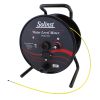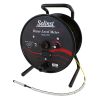Heron SKINNY DIPPER Water Level Meters
Features
- Narrow 1⁄4" tape and probe
- Tape guide and third hand well casing hanger included
- Heron carry bag included
- Free ground shipping
- Expedited repair and warranty service
- Lifetime technical support
- More
Overview
The Heron SKINNY DIPPER is A specialized unit designed for narrow tubes and piezometers. The SKINNY DIPPER will signal water with a bright LED light and solid buzzer tone, allowing the user to make water level measurements accurate to 1/100th ft or to each millimeter. When contact is made with water, the SKINNY DIPPER signals the water shorts the probe tip and body to complete a circuit. There is no on/off switch--the switch is the water.
Tape Specifications
The SKINNY DIPPER uses a high-strength Polyethylene tape, the diameter of which is a narrow 1⁄4”. The flexible tape winds smoothly onto the tough Nylon reel. Inside the tape are embedded two stainless steel conductors, which carry the signal from the probe to the electronic module. The SKINNY DIPPER tape is marked to engineering scale: Feet and tenths with markings every 1/100ft.
Electronic Module Specifications
The SKINNY DIPPER includes a fully potted, fully field removable electronic module. The super bright red LED and buzzer are housed inside this water-tight module. The sensitivity dial on the SKINNY DIPPER allows false signals from cascading water to be tuned out, enabling the most accurate readings possible. The electronic circuit converts the DC battery current to an alternating current; this prevents corrosion and mineral build-up on the probe. The SKINNY DIPPER works on one 9-volt battery in an easy-access battery drawer mounted on the front of the module.
Probe Specifications
The SKINNY DIPPER comes with a weighted, slim line 1/4” (0.635cm) diameter probe. The narrow diameter of the probe makes the SKINNY DIPPER an ideal water level indicator for narrow tubes and direct push equipment.
Reel Specifications
The SKINNY DIPPER is a well-balanced unit. The stand-alone, sturdy steel frame is coated in Polyurethane for durability. The vinyl-coated carry handle is ergonomically designed for comfort and easier rewinding. The reel flanges and center hub are molded from high-strength Nylon turning on a stainless steel axle, allowing the smooth running of tape up and down the well or borehole. The third hand well casing hanger and tape guide are standard features on all Heron water level indicators.
- 1/4” (6.4mm) Polyethylene Tape
- 1/4” (6.4mm) Water Level Probe w/holder
- Electronic Panel with audio and visual signals (Fully Encapsulated to IP65) with Drawdown
- Sensitivity dial to tune out cascading water
- Vinyl ergonomic handle
- 9V Battery
- Backpack Carrying Case w/ adjustable straps, laptop & notepad pouches
In The News
Spring 2025 Environmental Monitor Available Now
In the Spring 2025 edition of the Environmental Monitor, we highlight partnerships across the world and the importance of collaboration between government agencies, universities, environmental groups, local communities, and other stakeholders. From great white shark research in Cape Cod to monitoring fisheries in Lake Erie, this latest edition underscores partnerships that connect stakeholders in a watershed through environmental data. With an emphasis on data sharing, a combination of real-time and discrete sampling keeps the public and partners informed of environmental conditions. Our writers also sought out science professionals dedicated to working with peers within and outside of the environmental sector.
Read MoreMonitoring Mariculture in the Gulf of Alaska
The mariculture industry in the Gulf of Alaska has been steadily growing in recent years, guided by ongoing research to help refine farm location and cultivation practices. A subset of aquaculture, mariculture focuses on rearing organisms in the open ocean. In Alaska, finfish farming is illegal, so most farms cultivate kelp, oysters, or a combination of the two. These small, locally operated farms started popping up in the Gulf of Alaska in the early 1990s, when shellfish farming first became legal. Kelp farming did not begin to catch on in the state until 2016. Many of the coastal areas that have grown interested in mariculture are historically commercial fishing communities.
Read MoreSupplying Seattle’s Drinking Water: Using Data Buoys to Monitor the Cedar River Municipal Watershed
Providing clean, safe, and reliable drinking water for the 1.6 million people in the greater Seattle area is a top priority for Seattle Public Utilities (SPU). With limited water supplies, SPU dedicates considerable resources to maintain its watersheds and mountain reservoirs. About 70 percent of Seattle Water comes from the Cedar River Municipal Watershed , and the other 30 percent comes from the South Fork Tolt River Watershed . [caption id="attachment_39574" align="alignnone" width="940"] Data buoy in Chester Morse Lake . (Credit: Kevin Johnson / Seattle Public Utilities) [/caption] Jamie Thompson, a fisheries biologist at SPU, monitors aquatic ecosystems centered on fish listed under the U.S. Endangered Species Act (ESA).
Read More
















